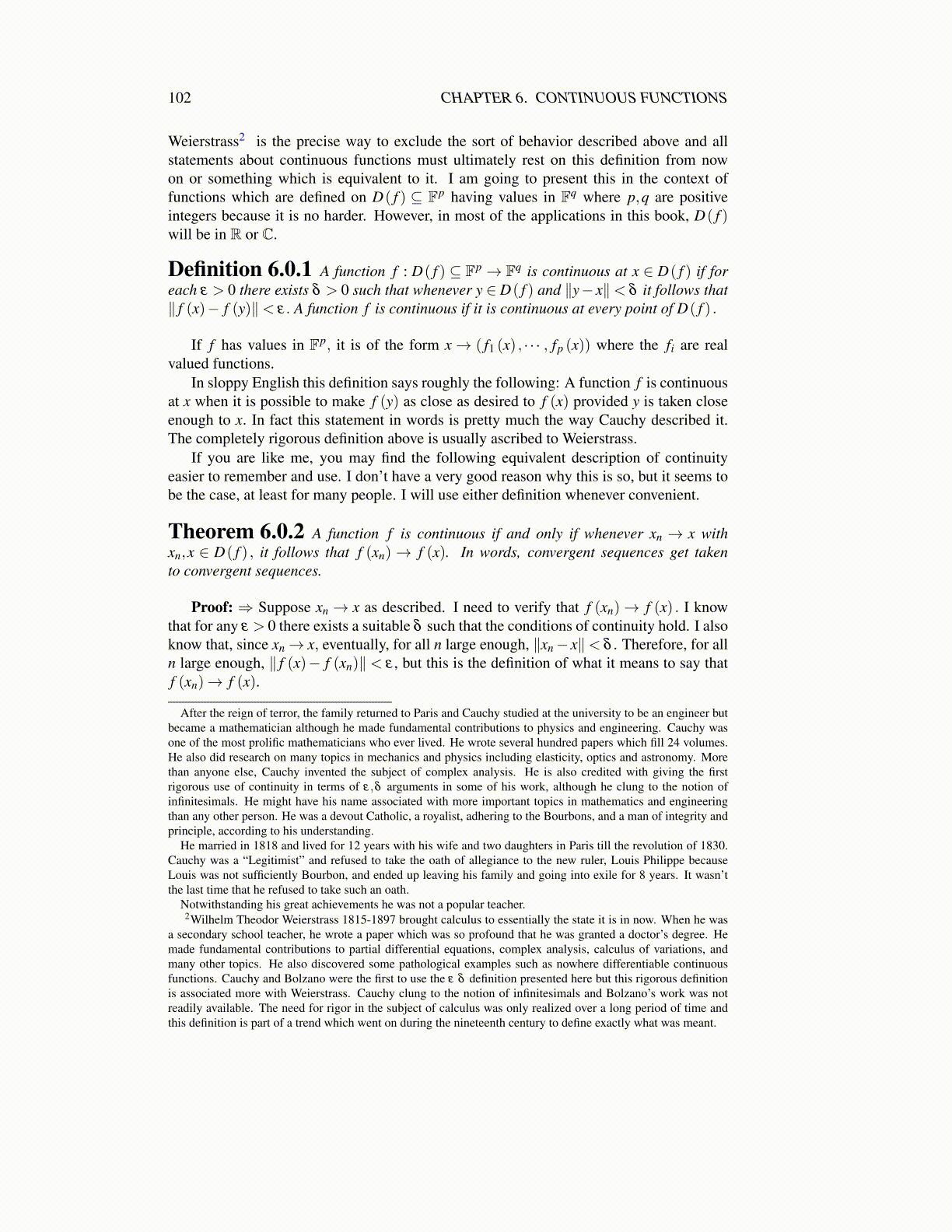
102 CHAPTER 6. CONTINUOUS FUNCTIONS
Proof: One of dist(x,S) ,dist(y,S) is larger. Say dist(y,S)≥ dist(x,S) . Then pick ŝ∈ Ssuch that dist(x,S)+ ε > ∥x− ŝ∥ . Then
|dist(x,S)−dist(y,S)| = dist(y,S)−dist(x,S)≤ ∥y− ŝ∥− (∥x− ŝ∥− ε)
≤ ∥y− x∥+∥x− ŝ∥− (∥x− ŝ∥− ε)≤ ∥y− x∥+ ε
If dist(x,S) > dist(y,S), reverse x,y in the argument. Since ε is arbitrary, this shows ∗.Then letting δ = ε in the definition for continuity shows x→ dist(x,S) is continuous.
The following is a useful theorem which makes it easy to recognize many examples ofcontinuous functions.
Theorem 6.0.8 The following assertions are valid
1. The function a f +bg is continuous at x when f , g are continuous at x ∈D( f )∩D(g)and a,b ∈ F.
2. If f has values in Fq and g has values in F are each continuous at x, then f g iscontinuous at x. If, in addition to this, g(x) ̸= 0, then f/g is continuous at x.
3. If f is continuous at x, f (x) ∈ D(g)⊆ Fp, and g is continuous at f (x) ,then g◦ f iscontinuous at x.
4. The function f : Fp→ R, given by f (x) = ∥x∥ is continuous.
Proof: All of these follow immediately from the theorem about limits of sequences,Theorem 4.4.8, and the equivalent definition of continuity given above, Theorem 6.0.2. Forexample, consider the third claim about the composition of continuous functions. Supposexn → x. Then by continuity of f , f (xn)→ f (x) and now, by continuity of g,g( f (xn))→g( f (x)). The other claims are similar.
6.1 Continuity at Every Point of D( f )Next is a useful property of continuous functions which has to do with preserving order.
Theorem 6.1.1 Suppose f : D( f ) → R is continuous at x ∈ D( f ) and supposef (xn) ≤ l (≥ l) for all n sufficiently large, where {xn} is a sequence of points of D( f )which converges to x. Then f (x)≤ l (≥ l) .
Proof: Since f (xn) ≤ l and f is continuous at x, it follows from Theorem 4.4.13 andTheorem 6.0.2, f (x) = limn→∞ f (xn)≤ l. The other case is entirely similar.
Now here is the main result about inverse images and continuity at every point.
Theorem 6.1.2 A function f is continuous at every point of its domain D( f ) if andonly if either of the two equivalent conditions hold. For
f−1 (S)≡ {x ∈ D( f ) : f (x) ∈ S} ,
1. f−1 (V ) =U ∩D( f ) for some U open whenever V is open.
2. f−1 (H) =C∩D( f ) for some C closed whenever H is closed.